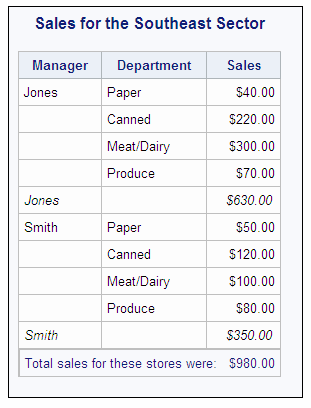REPORT Procedure
- Syntax

- Overview
- Concepts
- Using
- Results
- Examples
 Selecting Variables for a ReportOrdering the Rows in a ReportUsing Aliases to Obtain Multiple Statistics for the Same VariableConsolidating Multiple Observations into One Row of a ReportCreating a Column for Each Value of a VariableDisplaying Multiple Statistics for One VariableStoring and Reusing a Report DefinitionCondensing a Report into Multiple PanelsWriting a Customized Summary on Each PageCalculating PercentagesHow PROC REPORT Handles Missing ValuesCreating and Processing an Output Data SetStoring Computed Variables as Part of a Data SetUsing a Format to Create GroupsSpecifying Style Elements for ODS Output in the PROC REPORT StatementSpecifying Style Elements for ODS Output in Multiple StatementsUsing Multilabel FormatsUsing the WIDTH= and CELLWIDTH= Style Attributes with PROC REPORT
Selecting Variables for a ReportOrdering the Rows in a ReportUsing Aliases to Obtain Multiple Statistics for the Same VariableConsolidating Multiple Observations into One Row of a ReportCreating a Column for Each Value of a VariableDisplaying Multiple Statistics for One VariableStoring and Reusing a Report DefinitionCondensing a Report into Multiple PanelsWriting a Customized Summary on Each PageCalculating PercentagesHow PROC REPORT Handles Missing ValuesCreating and Processing an Output Data SetStoring Computed Variables as Part of a Data SetUsing a Format to Create GroupsSpecifying Style Elements for ODS Output in the PROC REPORT StatementSpecifying Style Elements for ODS Output in Multiple StatementsUsing Multilabel FormatsUsing the WIDTH= and CELLWIDTH= Style Attributes with PROC REPORT
Example 2: Ordering the Rows in a Report
| Features: |
COMPUTE statement arguments: AFTER
ENDCOMP statement
|
| Data set: | GROCERY |
| Formats: | $MGRFMT |
Program
libname proclib
'SAS-library';
options fmtsearch=(proclib);
proc report data=grocery nowd
colwidth=10
spacing=5
headline headskip;
column manager department sales;
define manager / order order=formatted format=$mgrfmt.; define department / order order=internal format=$deptfmt.;
define sales / analysis sum format=dollar7.2;
break after manager / ol
summarize
skip;
compute after;
line 'Total sales for these stores were: '
sales.sum dollar9.2;
endcomp;
where sector='se';
title 'Sales for the Southeast Sector'; run;
Program Description
Specify the format search library.The SAS system option FMTSEARCH= adds the SAS library
PROCLIB to the search path that is used to locate formats.
Specify the report options. The
NOWD option runs PROC REPORT without the REPORT window and sends its
output to the open output destinations. COLWIDTH=10 sets the default
column width to 10 characters. SPACING= puts five blank characters
between columns. HEADLINE underlines all column headings and the spaces
between them at the top of each page of the report. HEADSKIP writes
a blank line beneath the underlining that HEADLINE writes.
Define the sort order variables. The values of all variables with the ORDER option
in the DEFINE statement determine the order of the rows in the report.
In this report, PROC REPORT arranges the rows first by the value of
Manager (because it is the first variable in the COLUMN statement)
and then by the values of Department. ORDER= specifies the sort order
for a variable. This report arranges the rows according to the formatted
values of Manager and the internal values of Department (np1, np2,
p1, and p2). FORMAT= specifies the formats to use in the report.
define manager / order order=formatted format=$mgrfmt.; define department / order order=internal format=$deptfmt.;
Define the analysis variable. Sum
calculates the sum statistic for all observations that are represented
by the current row. In this report each row represents only one observation.
Therefore, the Sum statistic is the same as the value of Sales for
that observation in the input data set. Using Sales as an analysis
variable in this report enables you to summarize the values for each
group and at the end of the report.
Produce a report summary. This
BREAK statement produces a default summary after the last row for
each manager. OL writes a row of hyphens above the summary line. SUMMARIZE
writes the value of Sales (the only analysis or computed variable)
in the summary line. PROC REPORT sums the values of Sales for each
manager because Sales is an analysis variable that is used to calculate
the Sum statistic. SKIP writes a blank line after the summary line.
Produce a customized summary. This
COMPUTE statement begins a compute block that produces a customized
summary at the end of the report. The LINE statement places the quoted
text and the value of Sales.sum (with the DOLLAR9.2 format) in the
summary. An ENDCOMP statement must end the compute block.
